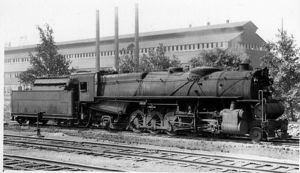PRR N1s
 PRR N1s #7246 at Youngstown, Ohio in 1919, when less than a year old. Note the Lines West central headlight (later relocated higher) and high slope-sided tender coal space. | |
| Power type | steam |
|---|---|
| Designer | PRR's Fort Wayne Shops |
| Builder | ALCO-Brooks (35), Baldwin (25) |
| Build date | December 1918 – 1919 |
| Total production | 60 |
| Configuration | 2-10-2 |
| Gauge | 4 ft 8½ in (1435 mm) |
| Boiler pressure | 215 psi (1.48 MPa) |
| Fire grate area | 79.9 ft² (7.4 m²) |
| Top speed | 35 mph (56 km/h) |
| Career | Pennsylvania Railroad |
| Retired | all retired by 1950 |
| Disposition | scrapped |
The Pennsylvania Railroad's N1s was a class of steam locomotive built for Lines West. They were of 2-10-2 "Santa Fe" wheel arrangement, ten driving wheels with a two-wheel leading truck and a two-wheel cast KW-pattern trailing truck under a giant firebox. This arrangement was well suited to the N1s' intended purpose, which was as a heavy drag freight engine for coal and iron ore traffic to and from lakeside ports. The design was developed by the PRR's Fort Wayne Shops and orders were placed with Alco (Brooks) (35 locomotives) and Baldwin (25 locomotives) for a total of 60; the first Alco locomotive was delivered in December 1918, with the remainder arriving during 1919.
The N1s was a large locomotive; the boiler was the largest then used on any non-experimental PRR locomotive, with a large Belpaire firebox with 79.9 square feet (7.4 m²) of grate area and a 5 foot (1.5 m) long combustion chamber. No feedwater heater was fitted, but a mechanical stoker and power reverse were, necessities on such a large locomotive. Boiler pressure was 215 pounds force per square inch (1.48 MPa), although it was designed to take a pressure of 250 lbf/in² (1.7 MPa).
To allow the locomotive to negotiate tight 23-degree curves, the first and fifth driving axles were fitted with lateral motion devices and the center pair of drivers were blind.
In many respects, the N1s was similar in ability to the I1s 2-10-0 "Decapod". Driver diameter, weight on drivers and cylinder size were almost identical. The N1s' boiler was larger, but of a lower pressure. The I1s' tractive effort was a little higher, while the N1s had a superior factor of adhesion. The N1s, as a low-speed drag hauler, was limited to 35 mph (56 km/h), while the I1s was capable of 50 mph (80 km/h) or greater.
The N1s were the first class of large power withdrawn after diesel locomotives appeared; all were gone by 1950, and none were saved for display. Their task, low-speed drag haulage, was the diesel locomotive's forte.

